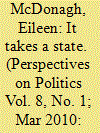| Srl | Item |
| 1 |
ID:
096280


|
|
|
|
|
| Publication |
2010.
|
| Summary/Abstract |
American women attain more professional success in medicine, business, and higher education than do most of their counterparts around the world. An enduring puzzle is, therefore, why the US lags so far behind other countries when it comes to women's political representation. In 2008, women held only 16.8 percent of seats in the House of Representatives, a proportion that ranks America lower than 83 other countries. This article addresses this conundrum. It establishes that equal rights alone are insufficient to ensure equal access to political office. Also necessary are public policies representing maternal traits that voters associate with women. Such policies have feedback effects that teach voters that the maternal traits attributed to women represent strengths not only in the private sphere of the home but also in the public sphere of the state. Most other democracies now have such policies in place, but the United States lacks such policies, which accounts for its laggard status with regard to the political representation of women.
|
|
|
|
|
|
|
|
|
|
|
|
|
|
|
|
| 2 |
ID:
133942


|
|
|
|
|
| Publication |
2014.
|
| Summary/Abstract |
Examining an original dataset of more than 8,500 antislavery petitions sent to Congress (1833-1845), we argue that American women's petition canvassing conferred skills and contacts that empowered their later activism. We find that women canvassers gathered 50% or more signatures (absolute and per capita) than men while circulating the same petition requests in the same locales. Supplementary evidence (mainly qualitative) points to women's persuasive capacity and network building as the most plausible mechanisms for this increased efficacy. We then present evidence that leaders in the women's rights and reform campaigns of the nineteenth century were previously active in antislavery canvassing. Pivotal signers of the Seneca Falls Declaration were antislavery petition canvassers, and in an independent sample of post-Civil War activists, women were four times more likely than men to have served as identifiable antislavery canvassers. For American women, petition canvassing-with its patterns of persuasion and networking-shaped legacies in political argument, network formation, and organizing.
|
|
|
|
|
|
|
|
|
|
|
|
|
|
|
|
| 3 |
ID:
120968


|
|
|